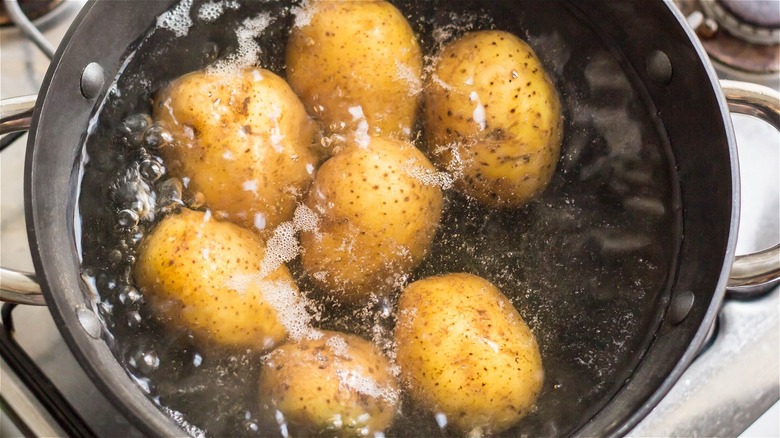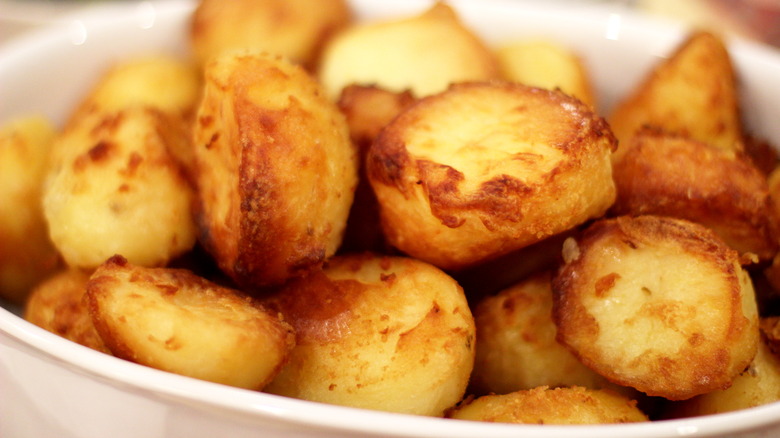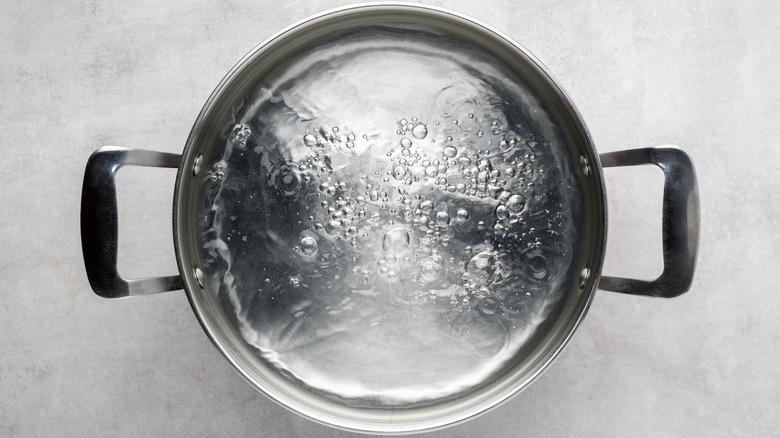Why You Should Parboil Potatoes Before Roasting
Baked, mashed, roasted, au gratin, scalloped, or fried, Americans love their potatoes. A 2019 survey by Potatoes USA revealed that tubers are our favorite vegetable, consumed at least once a week by 78%, followed by broccoli, tomatoes, and corn. Although over 200 types of potatoes are available in the U.S., most supermarkets offer less than a dozen varieties ranging from large Russets to finger-like fingerlings. Each potato, with its varying size, shape, starch content, skin, and flavor, lends itself best to a particular cooking method (via Potato Goodness).
For instance, although they'd be adorable, a marble-sized petite potato would not be well suited for a twice-baked potato, while the thick-skinned and large Russet is ideal. With the holiday season, most tables will likely serve the labor-intensive but deeply satisfying traditional mashed potatoes to accompany their turkey. Although they seem simple enough to make, mashed potatoes, when not prepared properly, can end up gummy, lumpy, and bland. Beginning with choosing the wrong potato, there are many ways to mess up America's beloved side dish, including cutting the potatoes too small when boiling and overworking the spud with an overly eager hand mixer, stand mixer, or food processor, which is why some home cooks are opting for roasted potatoes this holiday (via Food Network).
With a few tips, a crispy potato nugget with a fluffy, creamy interior is less than an hour away. Enjoy it for your Thanksgiving feast, and again each time you are craving crispy roasted potatoes.
The crispiest roasted potatoes
Perfect roasted potatoes are more than cut-up potatoes drizzled with oil and seasoned with salt and pepper. While that method will give you a marginally crisp potato momentarily, according to Serious Eats, the steam from the potato's interior will turn them limp in no time. The problem with that technique is the layer of crispiness on the roasted potato is too thin, but there is a solution.
Begin with a Russet potato for its high starch content. Then parboil or partially cook the peeled and cubed potatoes before roasting them, providing a layer of "dehydrated gelatinized starch" while keeping the center of the potato nuggets firm enough for the second cooking in the oven. The thicker you can get that starchy layer, the crispier the outside of your roasted potato will be.
As an insurance policy against overcooking the potatoes, add a tablespoon of white vinegar to the water as you boil the potatoes. The acidic water will strengthen the pectin in the potato, which holds the tuber together. To further increase the crispiness, manhandle the par-cooked potatoes, increasing the surface area as they get dinged up. When tossing the par-cooked potatoes with the fat and seasoning of your choice, use a metal utensil to create small dents and dings where more gelatinized starch will crisp up when roasted over high temps. Finally, please resist the urge to flip the roasted potatoes too early and sit back until they are done to golden perfection.
What does it mean to parboil?
While the term may seem pretty straightforward, parboiling is more than meets the eye. To parboil a potato means to partially cook the potato in boiling water. The main reason to do this is to soften the potato slightly before popping it into the oven to roast. While you can just put potatoes directly into the oven to cook them, the final texture will be different (per Kitchen Seer). When the potatoes are lightly cooked beforehand, it's easier for the oven to do its job of making the potatoes nice and crispy. According to First For Women, potatoes run the risk of turning into a mushy mess when boiled. That's why it's important to parboil the potatoes instead of boiling them until fully cooked.
There is actually an art to parboiling potatoes to ensure the best outcomes. The trick to getting your potatoes to the perfect level of partially cooked is covering the potatoes in a pot of cold water. Love Potatoes reports that if you put the potatoes in boiling water, the outside will cook faster than the inside. Heating the water slowly allows for even cooking. First For Women advises that the potatoes should be cleaned with a brush to remove any extra dirt. Next, drop them in a pot of cold water and turn the heat up to high until it boils. Once boiling, turn the heat to medium-low and cook until the potatoes are tender. Now that the potatoes are parboiled, it's time to roast.


